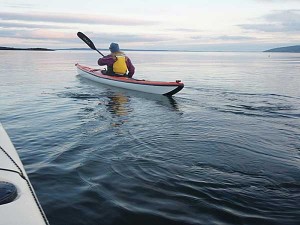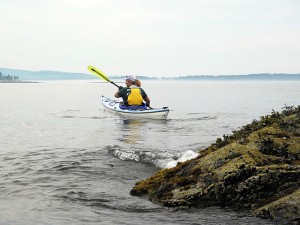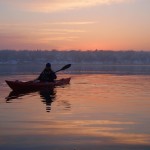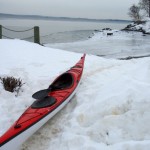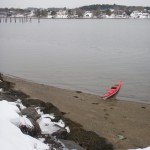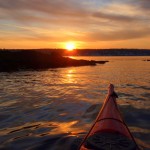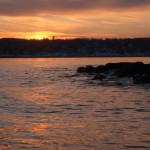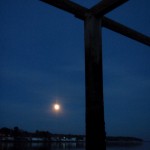The following is part one of a two-part guest blog by Leslie Gregory of Swanville, Maine. Paddling with Leslie, I am frequently reminded that when seeking adventure or beauty, it is not always necessary to look far from home.
——————————————————————————————————————-
2/28 A few miles north of town, there flows a river. It drops out of a lake and winds exhaustingly around muddy bends, startling out pairs of ducks and groupings of geese. Other days, the river is frozen, and on a good year offers a week of skating for miles and miles. Some years, I can ski on snow along the river’s edge that reminds me of confectioner’s sugar. The river runs parallel to a road, and while the length of the road is 7.3 miles, there are dozens of miles of kayaking and canoeing, hunting, fishing, skiing, snowmobiling, biking, ATVing and hiking within a few miles of the river’s edge. The word paradise comes to mind.
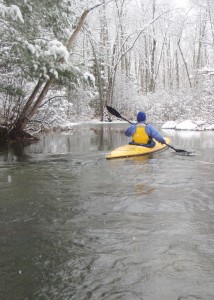 I only made it up to Sugarloaf once last year for its epic winter of downhill skiing. But at least 50 times in the 2011 winter, I put on my skis and journeyed out my back door for another adventure. Depending on the wind and conditions of trails, I would ski on the river’s edge or find vantage points to visit. Then came the ice. That’s when the groomed snowmobile trails really came in handy.
I only made it up to Sugarloaf once last year for its epic winter of downhill skiing. But at least 50 times in the 2011 winter, I put on my skis and journeyed out my back door for another adventure. Depending on the wind and conditions of trails, I would ski on the river’s edge or find vantage points to visit. Then came the ice. That’s when the groomed snowmobile trails really came in handy.
My son spent many Saturdays zipping over to the pond on his snowmobile, dragging the jet sled behind, loaded up with a tent, heater, sandwiches and iced tea. I’d ski over to say hi and check on them, then follow the river’s curves south. He almost always got a fish or at least a flag, and in the spring, he’ll be back in his canoe, bobbing for bass.
4/8 Whitewater has had my attention these last few weeks which has kept me out of the hood, but it’s time to run across the street and check on my kayak, and see if the river is open at my neighbor’s put in. No whitewater here, though I’ve seen this river billed as class 2 or 3. Only if you count the drops over the beaver dams! I know there are a few lingering ice shelves, but it won’t be long til I can run down my neighbor’s driveway and launch my kayak for a quick sunset paddle. The geese will be there, the ducks will be hiding in the grass.
4/14 Sure enough I did go for a paddle this afternoon. The days are getting longer so I was out before sunset. The river is flooded, the grass and cattails a study in muddy banks. I’ve been out a few times a week to see the different stages of spring. Eagles and osprey fish from tall pines, and the geese and ducks rise off the water, always startled and vigilant. The river is narrow and wooded in parts but opens into floodplains and ponds. It is wetlands along much of its shore, so a tumble into the water could result in some pretty nasty recovery work. Mud mud mud — I’ve felt it claim my neoprene boots, sucking and schlucking me deeper. The river was carved out in its banks and very full today. It made me feel full in my chest, happy, delighted.
I paddled with the wind and current til I got to the gusting pond, circled around and paddled up against the wind and current, both of which were thankfully mild. Over the scattered beaver dams, a few weeks ago I couldn’t get through without portaging. I could come here every day, and it would be different each day. Some days are still and cold, others raucous and windy. The sky is ever changing, a marmalade of blue and white, greys and purples. In a few months, the river will be overgrown at my put in and difficult to navigate. Then it will rain a few days, and it will be brimming, nudging at my kayak to launch.
6/7 When approached from the shore, the river is uninviting, and inaccessible, a small ribbon of wet amongst blowdowns and grass clods. But there is something compelling about it. I’ll think of it as one might a dear friend, “I wonder how so and so is doing?” My thoughts are punctuated by musings of how the river is doing, is it full and flooded, can you see the huge clumps of mud, are the redwinged blackbirds back?
I rode my bike across the street just to check. The level was going down fast. My feet were caked with mud getting in the boat. The ducks harbored in the deep grass, the males darted out to divert my attention from their young, switchbacking around curves until they skimmed across the water’s surface, launched into a golden afternoon, and then circled back around. Mayflies lifted on a curl of breeze, and the mosquitoes gathered in the cooling afternoon. Rippling a glass surface, bass and pickerel surfaced on the sunlit pond for feeding.
June 18 Here’s one of my favorite little workouts in the summertime: we drive down to the lake to my folks’ house where Baxter will mow the lawn. I hop in River Runner, my whitewater kayak, and charge the stiffening southwest breeze, paddle nonstop 3 miles to the dam, portage the dam to the river on the other side, and ride the twisting shallow waters, swatting at horseflies, mosquitoes and swampbrush. I navigate the beaver dams, sometimes portaging, sometimes directing my boat off to the side with my hands grabbing at branches and sometimes just riding my boat over the neatly woven branches that further diminish the flow of water below. I arrive, bugbitten and briar scratched, take out at my normal put-in, run the long driveway and up the hill to my house, take 5 minutes to drink water and regroup, hop on my bike and head back to the lake, where Bax is just popping open an iced tea on the deck to take in the view. A few days later, I do it in reverse, leaving my house to go up river, ride the southwest breeze down the lake, rejuvenate on the deck and then bike home. Life is good in the summertime.
July 26 The summer days have been filled with lake paddling and ocean ventures. This afternoon I helped with a tour on the bay, and we paddled up to the mouth of Goose River where the dam holds back a lovely pool of green sparkles. The rising moon was almost full as it played hide and seek with the horse tail clouds. I contemplated the up-river –how it is overgrown and shambling over dead branches and muddy compost, alongside balled clumps of tall rivergrass. It’s been awhile since I’ve biked across the street, and my river kayak is enjoying early retirement at the lake. It’s nice to see the river spilling over the mossy green rocks here, splashing white moonlight into a waning sunset. I always think of the river winding aimlessly through woodlands and grasslands, rarely do I see this convergence where the eels and seaweed rush in with the rising tide. I linger in this zenith, holding the moment.
